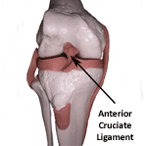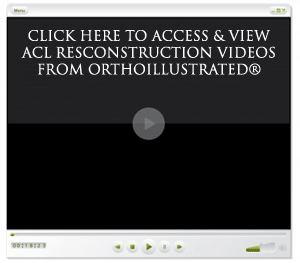
The anterior cruciate ligament (ACL) is a
ligament in the knee that courses from the posterolateral
wall of the intercondylar notch to the anteromedialtibial
plateau. The ligament is partially responsible for the
complex kinematics of knee range of motion. Specifically,
the ACL is responsible for limiting anterior tibial
translation and internal rotation of the tibia.
Tears of the ACL are very common in athletes both young and
old. It is estimated that over 200,000 ACL injuries occur
every year in the US. Unfortunately, it is challenging to
return to higher demand cutting sports without an ACL.
Occasionally, high level athletes are able to return after
an intensive physical therapy regimen. More commonly,
however, an ACL reconstruction is required for return to
high level athletics.
Injury to the ACL was once thought to be a career ending
injury for athletes before the 1970’s. ACL reconstruction or
replacing surgeries have been described since 1903. Early
efforts with silk ligaments were not particularly
successful. For many years, extra-articular reconstuctions
using the iliotibial band were utilized in an attempt to
stabilize the knee joint. These techniques were met with
variable levels of success. The first use of the patellar
tendon for ACL reconstruction was by Dr. EnjarEricksson of
Sweden. His reconstruction technique utilized the intact
insertion of the patellar tendon to stabilize the knee.
After Dr. William Clancy attended one of his lectures, he
built on the choice of the graft patellar tendon for
reconstruction. Dr. Clancy took the next crucial step of
taking that graft and placing that graft into drilled
tunnels at the origin and insertion of the ACL. Early
results were extremely encouraging and the modern ACL
reconstruction was born.
The Clancy technique of ACL reconstruction was successful
based on a few key reasons. First the graft was placed in
the correct anatomic position. Secondly, the graft was
rigidly fixed into position to avoid migration during the
healing process. Finally, the patellar tendon graft
incorporated into the tunnels quickly and remodeled
efficiently into a ligament following implantation.
“History is nothing more than taking two steps forward and
one step back," Dr. Clancy says. "That has been the total
history of the ACL." Early rehabilitation included up to six
weeks in a cast prior to initiating motion. Needless to say,
we have made some improvements over the years with regard to
our postoperative care of ACL reconstructions. The evolution
of the surgical technique of ACL reconstruction, however,
has not maintained the anatomic accuracy that is required
for successful reconstructions.
The original technique of ACL reconstruction involved two
incisions to place the graft. One incision was made to drill
the tibial tunnel. Another incision was made up on the
lateral aspect of the femur to drill the femoral tunnel. One
of the key ingredients to success with this technique was
the ability to independently drill the tibial and femoral
tunnels. This allows anatomic placement of both the origin
and insertion of the ligament reconstruction. Where else
would you want to put it??
As arthroscopic techniques evolved, an all arthroscopic ACL
reconstruction technique referred to as the “transtibial
technique” took over in the mid 1990’s. The minimally
invasive nature of the technique and relative simplicity
allowed this technique to flourish for many years. Even
today, this is the most common technique used for ACL
reconstruction. The technique involves drilling the tibial
tunnel in a standard fashion. The femoral tunnel is then
drilled through the tibial tunnel making no further
incisions. The literature has shown that it is nearly
impossible to place both the tibial and femoral tunnels in
the anatomic position with the transtibial technique. The femoral tunnel is towards the
ceiling (or 12 o’clock) position in the intercondylar notch.
This does not approximate the native ACL anatomy. That
is why this technique is the “step back” in the evolution of
ACL reconstruction.
Reconstructing a ligament in this fashion creates a
nonanatomical tether that creates a normal Lachman’s test
and looks good on the KT-1000 testing. However, the
resulting vertical graft does not resolve the harder to test
rotational stabilizing component of the ACL. The transtibial
technique has been taught to countless orthopaedic surgeons
(including myself) over the last 20 years. Unfortunately,
even in the best hands, the results of this technique may
lead to abnormal stresses on the articular cartilage and
leading to earlier osteoarthritis.
Over the last 20 years, countless articles have been
published comparing bone patellar tendon bone grafts to
hamstring grafts. (Minimal differences have been noted from
study to study) There is still no consensus on which graft
is really preferred. In short, both work fine. While this
mildly interesting debate labored over these 20 years, graft
after graft continued to be placed in a nonanatomic
position.
Fortunately, Dr. Freddie Fu from the University of
Pittsburgh, brought this anatomical dilemma to the forefront
of the ACL debate after his introduction of the double
bundle reconstruction. Dr. Clancy had been telling people
that the transtibial technique was incorrect for years, but
his protests fell on largely indifferent ears…
Dr. Fu’s work out of Pittsburgh reaffirmed the importance of
the femoral origin of the ACL and the anatomically incorrect
nature of the transtibial technique. His evaluation with 3D
CT scans of his own transtibial ACL reconstructions
demonstrated that not one of his femoral tunnels were in the
anatomic femoral origin of the ACL. Through the work of Dr.
Fu and Clancy, there has been a resurgence of anatomical ACL
reconstruction focusing on putting the graft in the correct
location.
BACK TO THE FUTURE…
With current techniques, we are able to place the ACL graft
in the correct position with arthroscopic techniques. The
arthroscopic anatomical ACL reconstruction drills the tibial
tunnel in the standard fashion. The femoral tunnel is then
drilled through a separate small incision near the medial
arthroscopic portal allowing anatomic placement of the
femoral tunnel.

With the drilling of the femoral tunnel from the medial
portal. One can position the femoral tunnel down the wall of
the intercondylar notch where the native ACL origin is
located.
Generally speaking, the results of ACL reconstructions
overall is quite good. Most athletes with a reconstructed
ACL can return to play with a functionally stable knee. The
problem that I see is the high rates of osteoarthritis in
knees after ACL reconstruction. Longitudinal studies from
the Swedish Registry has shown that having an ACL
reconstruction does not decrease the rate of arthritis when
compared to a matched cohort that went without
reconstruction after their injury. Put another way, ACL
reconstruction with a transtibial technique does not reduce
the chance of osteoarthritis in the knee when compared to
unstable/unreconstructed knees.
The hypothesis is that with an anatomic reconstruction, the
stresses across the articular cartilage will normalize and
hopefully lead to a decreased incidence of osteoarthritis in
the knee. Osteoarthritis of the knee after an injury to the
ACL is clearly multifactorial in nature. However, if we can
avoid placing a nonanatomic tether, we may have a better
chance at recreating a normally functioning knee.
If we have the ability to place the graft in the correct
anatomic position, why wouldn’t we? So you can debate what
graft to use, when to stress it, when to brace it, how to
rehabilitate it, and how to fixate the graft. These points
are certainly finer points in obtaining optimal results with
an ACL reconstruction. It is my opinion that placing the
graft in the right position is the most often overlooked and
very important aspect of obtaining a great long term result
in ACL reconstruction.










